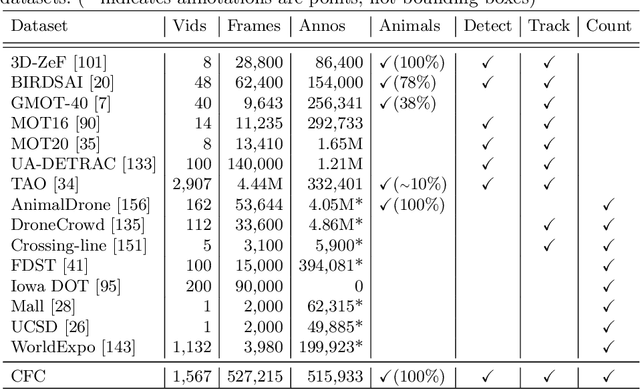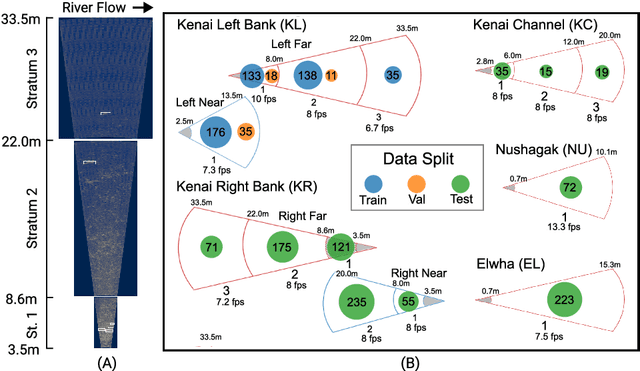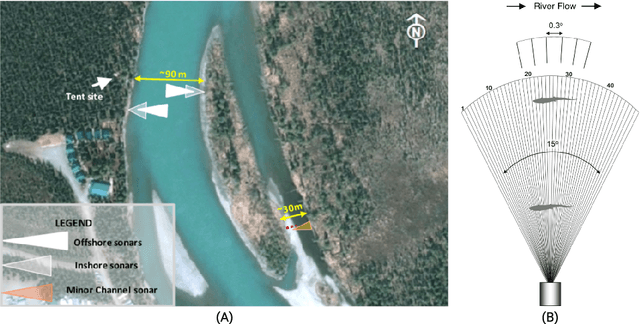Suzanne Stathatos
School of Computing and Mathematical Sciences California Institute of Technology
SAVeD: Learning to Denoise Low-SNR Video for Improved Downstream Performance
Mar 31, 2025Abstract:Foundation models excel at vision tasks in natural images but fail in low signal-to-noise ratio (SNR) videos, such as underwater sonar, ultrasound, and microscopy. We introduce Spatiotemporal Augmentations and denoising in Video for Downstream Tasks (SAVeD), a self-supervised method that denoises low-SNR sensor videos and is trained using only the raw noisy data. By leveraging differences in foreground and background motion, SAVeD enhances object visibility using an encoder-decoder with a temporal bottleneck. Our approach improves classification, detection, tracking, and counting, outperforming state-of-the-art video denoising methods with lower resource requirements. Project page: https://suzanne-stathatos.github.io/SAVeD Code page: https://github.com/suzanne-stathatos/SAVeD
Align and Distill: Unifying and Improving Domain Adaptive Object Detection
Mar 18, 2024



Abstract:Object detectors often perform poorly on data that differs from their training set. Domain adaptive object detection (DAOD) methods have recently demonstrated strong results on addressing this challenge. Unfortunately, we identify systemic benchmarking pitfalls that call past results into question and hamper further progress: (a) Overestimation of performance due to underpowered baselines, (b) Inconsistent implementation practices preventing transparent comparisons of methods, and (c) Lack of generality due to outdated backbones and lack of diversity in benchmarks. We address these problems by introducing: (1) A unified benchmarking and implementation framework, Align and Distill (ALDI), enabling comparison of DAOD methods and supporting future development, (2) A fair and modern training and evaluation protocol for DAOD that addresses benchmarking pitfalls, (3) A new DAOD benchmark dataset, CFC-DAOD, enabling evaluation on diverse real-world data, and (4) A new method, ALDI++, that achieves state-of-the-art results by a large margin. ALDI++ outperforms the previous state-of-the-art by +3.5 AP50 on Cityscapes to Foggy Cityscapes, +5.7 AP50 on Sim10k to Cityscapes (where ours is the only method to outperform a fair baseline), and +2.0 AP50 on CFC Kenai to Channel. Our framework, dataset, and state-of-the-art method offer a critical reset for DAOD and provide a strong foundation for future research. Code and data are available: https://github.com/justinkay/aldi and https://github.com/visipedia/caltech-fish-counting.
Teaching Computer Vision for Ecology
Jan 05, 2023


Abstract:Computer vision can accelerate ecology research by automating the analysis of raw imagery from sensors like camera traps, drones, and satellites. However, computer vision is an emerging discipline that is rarely taught to ecologists. This work discusses our experience teaching a diverse group of ecologists to prototype and evaluate computer vision systems in the context of an intensive hands-on summer workshop. We explain the workshop structure, discuss common challenges, and propose best practices. This document is intended for computer scientists who teach computer vision across disciplines, but it may also be useful to ecologists or other domain experts who are learning to use computer vision themselves.
Conservation Tools: The Next Generation of Engineering--Biology Collaborations
Jan 03, 2023



Abstract:The recent increase in public and academic interest in preserving biodiversity has led to the growth of the field of conservation technology. This field involves designing and constructing tools that utilize technology to aid in the conservation of wildlife. In this article, we will use case studies to demonstrate the importance of designing conservation tools with human-wildlife interaction in mind and provide a framework for creating successful tools. These case studies include a range of complexities, from simple cat collars to machine learning and game theory methodologies. Our goal is to introduce and inform current and future researchers in the field of conservation technology and provide references for educating the next generation of conservation technologists. Conservation technology not only has the potential to benefit biodiversity but also has broader impacts on fields such as sustainability and environmental protection. By using innovative technologies to address conservation challenges, we can find more effective and efficient solutions to protect and preserve our planet's resources.
The Caltech Fish Counting Dataset: A Benchmark for Multiple-Object Tracking and Counting
Jul 19, 2022



Abstract:We present the Caltech Fish Counting Dataset (CFC), a large-scale dataset for detecting, tracking, and counting fish in sonar videos. We identify sonar videos as a rich source of data for advancing low signal-to-noise computer vision applications and tackling domain generalization in multiple-object tracking (MOT) and counting. In comparison to existing MOT and counting datasets, which are largely restricted to videos of people and vehicles in cities, CFC is sourced from a natural-world domain where targets are not easily resolvable and appearance features cannot be easily leveraged for target re-identification. With over half a million annotations in over 1,500 videos sourced from seven different sonar cameras, CFC allows researchers to train MOT and counting algorithms and evaluate generalization performance at unseen test locations. We perform extensive baseline experiments and identify key challenges and opportunities for advancing the state of the art in generalization in MOT and counting.
 Add to Chrome
Add to Chrome Add to Firefox
Add to Firefox Add to Edge
Add to Edge